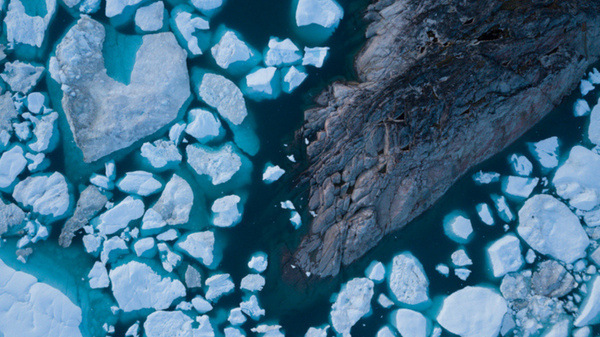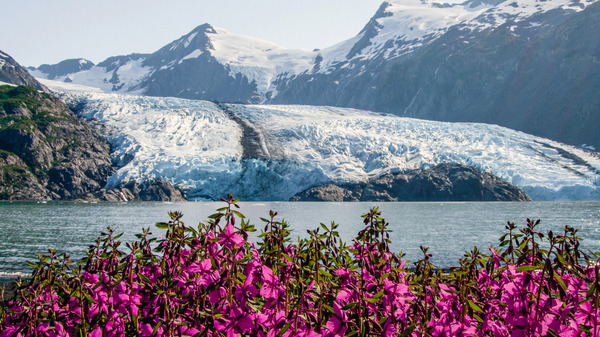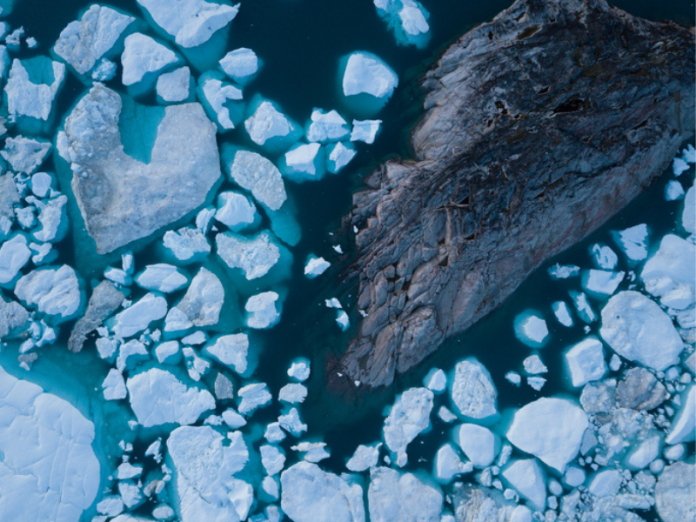YOU SHOULD SUBSCRIBE TO CLIMATE CHANGE WEEKLY.
IN THIS ISSUE:
- No, Melting Greenland Ice Is Not About to Swamp Coastal Areas
- Podcast of the Week: Some States Fight Crazy Energy Policies, Others Embrace Them (Guest: Tim Benson)
- Arctic Glacier Extent Greater Now Than In The Past
- Texas Fights Woke Investing
- Video of the Week: Insane Cost of Replacing an Electric Vehicle Battery Exposed
- BONUS Video of the Week: Why a Dud Hurricane Season … So Far?
- Climate Comedy
- Recommended Sites
No, Melting Greenland Ice Is Not About to Swamp Coastal Areas

A study published in Nature Climate Change in late August claimed anthropogenic climate change has already committed approximately 3.3 percent of the Greenland ice sheet to melting—approximately 110 trillion tons of ice. By itself, that would cause nearly a foot of global sea-level rise, the article stated. Even worse, the researchers estimate if the high-period ice loss experienced across 2011 through 2012 were to resume and continue throughout the end of the century, the ice melt could be 185 percent greater, with a correspondingly bigger sea level rise.
Corporate media outlets were quick to hype the extreme outlier projections of this single study. CBS News, CNBC, CNN, The New York Times, and The Washington Post, to name just a few, gave the report prominent, alarmingly headlined coverage.
As with so many frightening climate claims, in the words of Carl Sagan (which were a restatement of Pierre-Simon Laplace), “Extraordinary claims require extraordinary evidence.”
The study and the news stories hyping it definitely lack extraordinary evidence. Hard data backing up the claim of alarming amounts of Greenland ice melt driving increasing rates of sea level rise is absent, probably because such data does not exist.
As my colleague meteorologist Anthony Watts pointed out in a Climate Realism article addressing The Washington Post’s story about the Nature Climate Change study, all the scenarios in the report were based on computer model projections, and such projections have been consistently wrong in the past. This is not surprising: the models themselves have fatal flaws that make their projections untrustworthy:
One of the favorite scare stories that has continued to circulate about effects of climate change is the never-ending alarm over future sea level rise. Back in 1989, when today’s catch-all phrase of “climate change” was known as “global warming,” there was this prediction from the United Nations (UN) covered in an Associated Press story[:]
“A senior U.N. environmental official says entire nations could be wiped off the face of the Earth by rising sea levels if the global warming trend is not reversed by the year 2000.”
That claim voiced by the UN official was based on computer models projecting future sea levels. Obviously, the models were wrong, because [what was described in] that claim never happened. Today, 22 years past the due date, not one country, not even a city, has been “wiped off the face of the Earth by rising sea levels.”
The projections were wrong then, and the data indicates they are almost certainly wrong now. As Watts points out, although 110 trillion tons of ice loss sounds enormous, it is a minuscule portion of the total amount of ice in Greenland’s ice sheets. In addition, weather patterns, not climate change, dominate Greenland’s ice volume and its variations over time.
As Watts notes, in a July 2021 Guardian story the paper asserted “Greenland: Enough Ice Melted on Single Day to Cover Florida in Two Inches of Water.” That amount of melting would have amounted to more glacial melting in Greenland in a single day than NASA measured in the previous three decades, which indicates the Guardian’s claim was probably grossly false. Even if true, the Guardian failed to report on the next day’s weather in Greenland, during which all that melted water refroze when the clouds returned. The water never made it to the ocean, and thus it had no effect on sea levels.
The new study cited by The Washington Post and other corporate media climate alarm flacks failed to include the influence of weather patterns, assuming instead a simple linear causation from carbon dioxide in the atmosphere warming the planet to Greenland glacial melting. There is no such direct causal connection.
The same week as the model-driven study was published, data from the Danish Meteorological Institute (DMI) and Denmark’s Polar Portal undermined the claims of accelerating ice loss and provided factual support for Watts’ analysis.
On August 29, Greenland posted a gain of seven billion tons of ice. This represented the largest single-day ice gain the DMI has recorded since it began keeping consistent records in 1981, more than 40 years ago. This gain was remarkable not only for the amount of ice but because it came in the waning days of the Arctic summer, when ice is usually still melting. Other data from the DMI throws further shade on Nature Climate Change for publishing the ill-considered (and as it turns out, ill-timed) study, and the media outlets that publicized the report as terrifying breaking news. It turns out, according to the DMI, Greenland’s surface ice mass balance for the 2021-2022 ice year, even before fall and winter 2022 arrive, is well above the mean average for 1981 through 2010, the 30 year period DMI uses for comparison. And that was before Greenland gained an additional seven billion tons of ice on August 29.
To be fair, one day’s ice gain or loss (take note, Guardian!) doesn’t mean Greenland won’t suffer a net loss of ice over the next century. It may, or it may not. What it does show is that there is no direct connection between human greenhouse gas emissions and Greenland’s ice mass. Also, if Greenland is losing ice on net and contributing to accelerating sea level rise, something must be offsetting it: neither tide gauge records (see also Hedke) nor satellite data indicate the rate of sea level rise over the past 200 years has been accelerating consistently around the globe.
There are plenty of problems to solve and things to worry about in the world today without adding phantom fears of rising seas swamping the coasts because of ice loss in Greenland, based on flawed computer model projections.
SOURCE: Polar Portal; Newsbusters; Electroverse; Danish Meteorological Institute; Climate Realism
Podcast of the Week
California is leading the charge on misguided energy policies that are both ineffective at protecting the environment and markedly anti-consumer. Other states such as Florida and Texas are doing the opposite, fighting back against energy policies and corporate efforts, such as ESG programs, that hurt residents. Floridians and Texans will benefit while California’s residents watch their energy and transportation systems become less secure. People’s lives are being put at risk.
Both corporations and the government must not be allowed to force investment decisions on people. Blocking these anti-consumer efforts will expand freedom and economic well-being. Mandating only wind and solar removes individual choice and endangers lives.
Subscribe to the Environment & Climate News podcast on Apple Podcasts, iHeart, Spotify or wherever you get your podcasts. And be sure to leave a positive review!
Get your Copy at Amazon TODAY!
Arctic Glacier Extent Greater Now Than In The Past

A recent study published in the journal Climate of the Past shows there are more Arctic glaciers and ice caps at present, and they extend farther and are thicker, than at several times since the end of the last ice age, contrary to what is commonly claimed.
The research indicates the Arctic was warmer than at present between 8,000 and 4,000 years ago, with 80 percent to 100 percent of glaciers and ice caps (GICs) being smaller than today or absent entirely. If the research is correct, the Arctic’s modern ice extent is among the largest of the last 10,000 years, higher than even during the Roman and Medieval Warm Periods.
As No Tricks Zone reports, the paper from Laura J. Larocca and Yarrow Axford, scientists with the Department of Earth and Planetary Sciences at Northwestern University, indicates “any recession of GICs in the last few centuries is but a partial return to a former period of much greater warmth.”
The scientists’ conclusions are based on a comprehensive survey they conducted of the Arctic glaciers and ice caps near lakes and coasts in Alaska, Arctic Canada, Greenland, Iceland, Scandinavia, Svalbard, and the Russian Arctic. Larocca and Axford write,
For each region and for the full Arctic, we summarize evidence for when GICs were smaller than today or absent altogether, indicating warmer-than-present summers, and evidence for when GICs regrew in lake catchments, indicating summer cooling. … [T]he full Arctic compilation suggests that the majority (50 % or more) of studied GICs were smaller than present or absent by ∼10 ka. We find the highest percentage (>90 %) of Arctic GICs smaller than present or absent in the middle Holocene at ∼ 7–6 ka, probably reflecting more spatially ubiquitous and consistent summer warmth during this period than in the early Holocene. … Our review finds that in the first half of the Holocene, most of the Arctic’s small GICs became significantly reduced or melted away completely in response to summer temperatures that, on average, were only moderately warmer than today.
SOURCE: No Tricks Zone; Climate of the Past
Heartland’s Must-read Climate Sites
Texas Fights Woke Investing

In late August, the Texas Comptroller released a list of financial institutions in which state agencies are prohibited from investing, under a state law barring Texas government entities from stock fund management by, bank account holdings in, or brokering of bond sales with firms that boycott or call for divesting from companies involved in the oil and gas industry.
The Chairman of the Railroad Commission of Texas supported the move, warning, “If you boycott Texas oil and gas, we boycott you,” according to OilPrice.
A Texas law passed in 2021 prohibiting any state agency or political subdivision of the state, such as counties and municipalities, from entering into “a qualifying contract with a value of $100,000 or more for goods and services unless the contract contains a written verification from the contracted company that it does not and will not during the contract term boycott energy companies.”
The law also directs the Texas Comptroller to “prepare and maintain, and provide to each state governmental entity, a list of all companies that boycott energy companies.” The government entities are required to warn the companies on the comptroller’s list they are on it and they have 90 days to alter their anti-fossil fuel investment strategies. If a company or fund fails to remove its policies banning investment in companies in the fossil fuel industry, the government entity “shall sell, redeem, divest, or withdraw all publicly traded securities of the company,” the law states.
Since the law has passed, several municipal bond sales initially planned for offering by banks boycotting oil and gas companies were withdrawn and offered by alternative, legally compliant financial institutions.
The firms on Texas’ blacklist of banned companies include a roster of giants in the fields of banking, investment banking, and portfolio management: some ESG funds managed by Goldman Sachs and JP Morgan, BlackRock (the world’s biggest asset manager), BNP Paribas, Credit Suisse Group, Danske Bank, Jupiter Fund Management, Nordea Bank, Schroders PLC, Svenska Handelsbanken, Swedbank, and UBS Group. The list of banned funds names more than 350 firms.
“My greatest concern is the false narrative that has been created by the environmental crusaders in Washington, D.C., and Wall Street that our economy can completely transition away from fossil fuels, when, in fact, they will be part of our everyday life into the foreseeable future,” Texas Comptroller Glenn Hegar said in a statement announcing the list. “A complete divestment of the industry is not only impractical and illogical but runs counter to the economic well-being of Texas and our citizens.”
OilPrice reports,
The oil and gas regulator in the state, the Railroad Commission of Texas, welcomed the Comptroller’s move, [saying in a statement] that “Texas is leading the fight to curb the expansion of the Environmental, Social and Governance (ESG) movement, a woke investment strategy that places a priority on subjective environmental and social metrics instead of financial metrics that ensure quality returns for investors.”
“Texas is far from the only state dealing with this issue, with the Attorney Generals [AG] of 19 states signing a letter with similar sentiment last year,” OilPrice reports, noting the states’ actions are a growing response to and rejection of the “growing trend of Environmental, Social, and Governance (ESG) investment which many financial firms have embraced.”
The 19 state AGs sent a letter to BlackRock CEO Larry Fink in early August, saying they were concerned about his publicly stated commitment to reaching net-zero emissions across all his firm’s assets.
“Rather than being a spectator betting on the game, BlackRock appears to have put on a quarterback jersey and actively taken the field,” the attorney generals stated.
West Virginia State Treasurer Riley Moore said the Board of Treasury Investments, which manages the state’s roughly $8 billion of operating funds, announced in January 2022 the state would no longer do business with five financial institutions which he determined were working to undermine West Virginia’s economic well-being by pushing ESG and net-zero business investment: BlackRock, Goldman Sachs, JPMorgan Chase & Co, Morgan Stanley, and Wells Fargo.
“Any company that thinks Communist China is a better investment than West Virginia energy or American capitalism clearly has a bad strategy,” Moore said at the time.
SOURCE: Oil Price
Video of the Week: Insane Cost of Replacing an Electric Vehicle Battery Exposed
People think replacing the battery of an electric vehicle is as simple as a regular car. They’re wrong, but the price even surprised us.
BONUS Video of the Week: Democrats Hand Our Energy Independence to China
The National Oceanic and Atmospheric Administration (NOAA) predicted an active hurricane season earlier this year. Up until now, this hasn’t been the case, but there’s still time for this to change.
Stanley Goldenberg is on NOAA’s team that produces seasonal hurricane outlooks. He joins the program to discuss why this hurricane season was predicted to be active, what we should expect moving forwards, and how these predictions are made.
Tune in EVERY FRIDAY at noon CT for another LIVE episode of Climate Change Roundtable.






 via
via 























The press and the global warming crowd deliberately suppress the fact that ANTARCTICA has had record cold, snow and ice accumulation for decades. Even the last few years, ANTARCTICA cold, snow and ice have hit record numbers. The number of catastrophic hurricanes and tornadoes has dwindled the last couple of decades. The oceans have not risen appreciably other than the normal waxing and waning of ice melt and evaporation cycles. If you try to google it, the first few pages will be pro global warming but when you drill down to the more reputable “scientific” sites it says no global warming. Also droughts, cold snaps, and weather extremes are the rule all throughout recorded history. There are records clear back to the 1400’s verifying this fact. One has to dig for this data because the political and globalists agenda has big-tech, the leftist media, et al working at sequestering real facts as the “Brown Shirts” did for Hitler. Most folks don’t even go past the first page and these hyena Globalists at google know this.
Lastly, look up the sun-spot cycle which is an eleven year cycle. The weather patterns on earth are affected profoundly by this cycle.
They try to explain it away with all kinds of mental gymnastics but it doesn’t pass the smell test. Funny one never hears of this, but then again suppression of reality by ideologues is commonplace.
[…] From Heartland Daily News […]
[…] From Heartland Daily News […]
[…] From Heartland Each day Information […]
[…] Climate Change Weekly #446: No, Melting Greenland Ice Is Not About to Swamp Coastal Areas […]
[…] From Heartland Daily News […]